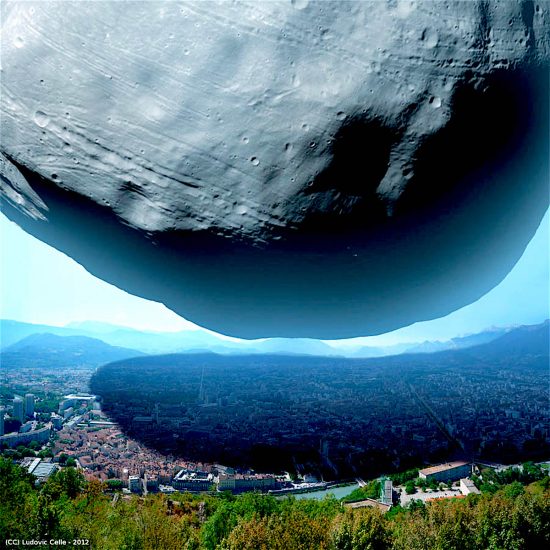May 18, 2017
Crater chains do not necessarily indicate impact features.
It is difficult to free fools from the chains they revere.
— Voltaire
According to a recent press release, a new study finds that the grooves on Phobos “…are the result of debris ejected by impacts eventually falling back onto the surface to form linear chains of craters.”
Phobos is the largest moon of Mars. Deimos is so small that studying its surface is problematic for astronomers because it cannot be observed well from Earth. Only the Viking 2 orbiter captured close up images. Phobos, on the other hand, has been examined by Earth stations and by satellites sent to Mars orbit.
Stickney crater is a ten kilometer wide crater that is nearly the size of Phobos. In previous Picture of the Day articles, it was argued that objects with craters almost as large as themselves should have been blasted into fragments, but little sign of the collisions is visible other than the craters. In the case of Phobos, the moon is 28 by 20 kilometers in size, so the crater is nearly half as large. Why did smashing the moon with an impact of that size not destroy it?
University of California Santa Cruz researchers report that striations and fracture lines evident around Stickney demonstrate that the moon did undergo severe shock and that it was distorted by the impact of whatever formed the crater. However, on closer examination, it was noted that the striations are, in reality, chains of small craters. No fracture lines are visible—no cracks as if from a titanic shock wave passing through the moon. In fact, the area surrounding the crater is rounded and smooth with no large blast debris (although the moon is covered with almost a meter of fine dust).
Phobos is in the same size range as some asteroids such as Mathilde, Eros and Ida. It exhibits features like the relatively gigantic craters that are endemic to those bodies, what is the common event that creates similar structures without obliterating the objects? The answer is electricity.
In past reviews of Mars, it was shown that electric arc discharges created its “mysterious” formations in a relatively short period. Gigatons of rock and dust were ejected from the planet and thrown into space at escape velocity. Blocks of stone as large as Manhattan Island fell back from a great height, leaving fields of enormous boulders with sharp, angular edges. Could it be that Phobos, Deimos, Ida and the rest are also the remains of an overwhelming cataclysm?
The thunderbolts that carved up Mars threw big chunks of crust into orbit, as well as into long ellipses around the Sun. While ramming through electric fields, the chunks were smoothed and eroded by the arcs. The result is that Phobos and the asteroids mentioned are covered in dust, have little or no large boulders, are defined by huge craters and look like they’re half-melted. Phobos does have one unique boulder, but its placement and size are a distinct anomaly.
In conclusion, Phobos and Deimos appear to be the remains of a catastrophic event that electrically devastated Mars.
Stephen Smith













